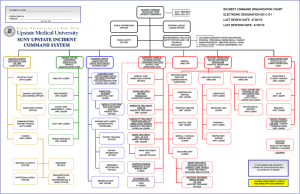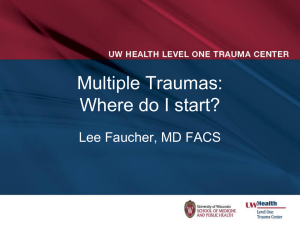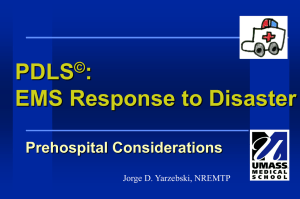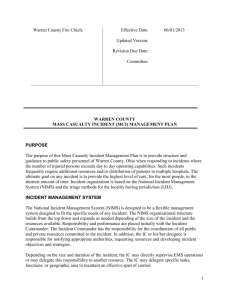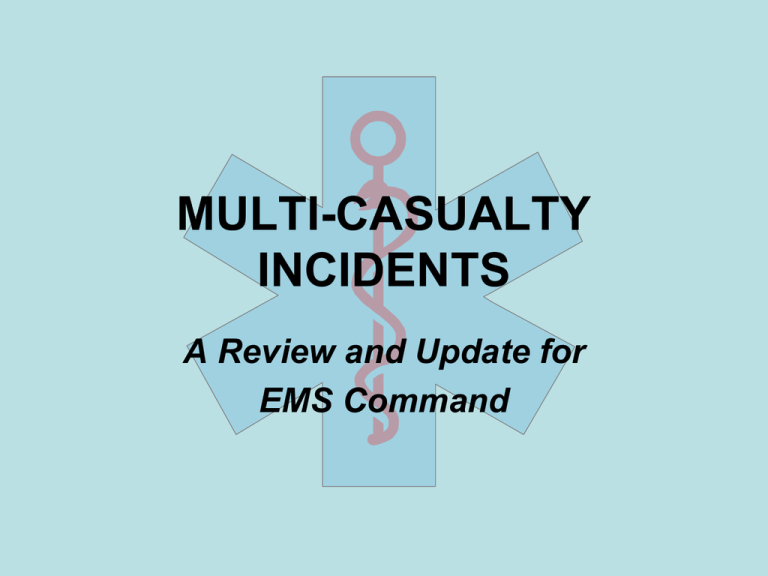
MULTI-CASUALTY
INCIDENTS
A Review and Update for
EMS Command
MCI Overview
• General Purpose:
– To review/refresh Multi-Casualty Incidents
and how they work in the Incident
Command sequence
• Appropriate identification of an MCI
• Initiation of the Incident Command System
• Build-out of the Incident Command System for:
– Small scale incidents
– Large scale incidents
MCI Overview
• Performance Objectives
– At the end of this presentation, the
participants shall be able to:
• Implement the Incident Command System for
an MCI
• Correctly identify an MCI
• Successfully navigate their assigned role in a
mock MCI
?
Has this happened to you
OR
Maybe you did this……..
Patients are in units and no one
knows anything about them.
The Medic left scene with the first
patient he/she saw.
You arrive. No information available
but….”See my cool Jimmie Jacks”.
Trauma patient count confused by
communications issues.
Packaged patients waited 10 minutes for transport
units that were requested one by one.
There has to be a better way!!!!!!!
You can do this!!!!
Initiate the Incident Command
Sequence
• 1st arriving unit officer should:
• Assume command
• Declare the incident an MCI
• Request additional resources
• Perform triage
Initiate the Incident Command
Sequence
• The following functions must occur:
– Triage
– Treatment area, if appropriate (small v.
large scale)
– Transport/Communications
Command Designation Options
• IC retains EMS functions (triage,
treatment, etc.)
• IC designates an EMS Group
Supervisor
– Build out based on incident scope/span of
control
TRIAGE/TREATMENT
• Small scale incident
– Apply Triage identifier (ribbon, tag)
– Report patient count to EMS Group
Supervisor or IC
• Regardless of Triage color
– Initiate treatment of patients in place
– No formal treatment area
TRIAGE/TREATMENT
• Large scale incident
– Apply Triage identifier
– Patients moved to designated Treatment
areas (Triage Officer)
– Patient information gathered in Treatment
area (Treatment Officer)
Treatment Areas
• Large scale event
• Assign group supervisor
– Sub-divide into appropriate colors
• Location Considerations
– Safety
– # of patients
– Removal of pts from scene
• Refine patient count
– Re-assess/re-triage
– #/color
• Update resource needs
Transportation/Communications
– HospitalCommunications
•
•
•
•
•
Sm v Lg scale
“Call Down” plan
High priority pts to appropriate hosp.
Dispatch center likely overwhelmed
Role of Communications Group Sup v
individual transport units
– Movement of Patients
• Based on hospital availability?
• Coordinate w/ Staging
• Record keeping
Communication Options
• Communications Officer may:
– make all communications with hospital(s)
– designate ALS consults only. All others
via Communications Officer.
ICS for the MCI
Incident Commander
EMS Group
Triage
Supervisor
Suppression Group
Treatment
Supervisor
Rescue Group
Transport/
Communications
Incident Commander
EMS Group
Triage
Treatment
1st arriving unit officer
(Can later be used in
Transp/Comm)
In place or designated areas
Transport
Communications
Consider ALS provider, EMS
supervisor
Command Resources
• Position documents
– Medical Group Supervisor
– Transportation Group Supervisor
• Patient tracking documents
– Transport Stubs
– Treatment Supervisor
– Treatment Disposition
MONTGOMERY COUNTY INCIDENT COMMAND SYSTEM WORKBOARD ©
3
TACTICAL
CHANNEL
MEDICAL GROUP SUPERVISOR
INCIDENT LOCATION
STAGING LOCATION
COMMAND
CHANNEL
SITUATION STATUS
MEDCOMM
CHANNEL
RESOURCE STATUS
NOTES
PATIENT COUNT
MEDICAL
GROUP
CHARLIE
INCIDENT COMMANDER
IMMEDIATE
OPS SECTION DIRECTOR
DELTA
STAGING MANAGER
MINOR
BRAVO
DELAYED
DECEASED
EMS BRANCH DIRECTOR
TOTAL
ALPHA
MED GROUP SUPERVISOR
MED SUPPLY COORDINATOR
TRIAGE UNIT LEADER
TRANSPORTATION
SUPERVISOR
MED COM COORDINATOR
TRIAGE UNIT
TASK OR OBJECTIVE
TIME
COMPLETED
TREATMENT UNIT
TASK OR OBJECTIVE
START TRIAGE COMPLETED
APPOINT TREATMENT LEADER
PROVIDE VEST & WORKBOARD
DETERMINE IF EXTRICATION AND
HAZMAT GROUPS ARE REQUIRED
IDENTIFY TREATMENT AREAS
BOTH
VISUALLY AND VERBALLY
ESTABLISH PERIMETER/ZONES
APPOINT TREATMENT MANAGERS
PROVIDE VESTS, WORKSHEETS
DETERMINE THE CASUALTY
COLLECTION POINT
SET UP MEDICAL SUPPLY
ESTABLISH / IDENTIFY TRIAGE
UNITS
ASSIGN LOADER UNITS
ASSIGN PORTER UNITS
DETERMINE TRANSPORTATION
NEEDS OF PATIENTS
ACCOUNTABILITY & PAR CHECKS
CONTACT TRANSPORTATION
GROUP
REASSIGN PERSONNEL AFTER
TASK COMPLETION
TRANSPORT IN ORDER OF
SEVERITY
MONITOR PERSONNEL, REHAB
MONITOR PERSONNEL, REHAB
TIME
COMPLETED
TREATMENT UNIT LEADER
TRIAGE UNIT(S)
PORTER UNIT(S)
MORGUE MANAGER
IMMEDIATE MANAGER
DELAYED MANAGER
MINOR MANAGER
TREATMENT DISPATCH
MANAGER
Version 11/27/07
4
MONTGOMERY COUNTY INCIDENT COMMAND SYSTEM WORKBOARD ©
TACTICAL
CHANNEL
TRANSPORTATION SUPERVISOR
INCIDENT LOCATION
STAGING LOCATION
MEDICAL GROUP
COMMAND
CHANNEL
SITUATION STATUS
TOTAL NUMBER OF PATIENTS TRANSPORTED
NOTES
TRANSPORT
GROUP
MEDCOMM
CHANNEL
RESOURCE STATUS
CHARLIE
CHANNEL
LOCATION
TOTAL
BRAVO
DELTA
SITUATION STATUS
MEDICAL GROUP
CHANNEL
LOCATION
ALPHA
INCIDENT COMMANDER
TOTAL
TASK OR OBJECTIVE
TIME
COMPLETED
APPOINT COORDINATORS
PROVIDE VESTS, WORKSHEETS
SITUATION STATUS
ACTIVATE MEDCOMM
OPERATIONS SECTION CHIEF
MEDICAL GROUP
DETERMINE HOSPITAL CAPABILITIES
CHANNEL
DETERMINE TOTAL PATIENT COUNT
AND SPECIAL TRANSPORT NEEDS
LOCATION
STAGING MANAGER
ESTABLISH AMBULANCE STAGING
TOTAL
ESTABLISH LANDING ZONE
DECLARE INGRESS/EGRESS FOR
GROUND TRANSPORT UNITS
EMS BRANCH DIRECTOR
SITUATION STATUS
REQUEST MORE TRANSPORTATION
UNITS AS NEEDED
MEDICAL GROUP
ASSIGN LOADERS
CHANNEL
TRANSPORTATION
SUPERVISOR
TRANSPORT IMMEDIATE PATIENTS
LOCATION
TRANSPORT DELAYED PATIENTS
TOTAL
TRANSPORT MINOR PATIENTS
MEDICAL COMMUNICATIONS
COORDINATOR
SITUATION STATUS
GROUND AMBULANCE
COORDINATOR
AIR AMBULANCE
COORDINATOR
MAINTAIN DOCUMENTATION
DEACTIVATE MEDCOMM
Version 11/27/07
MONTGOMERY COUNTY INCIDENT MANAGEMENT SYSTEM ©
TRANSPORT RECORDER
PAGE
1
2
3
4
5
6
7
8
RECEVING MEDICAL FACILITY
MEDICAL GROUP
MCFRS MCI
Worksheet # 4
Version 11/27/07
TRANSPORT STUBS
OF
MONTGOMERY COUNTY INCIDENT MANAGEMENT SYSTEM ©
3
PAGE
TREATMENT AREA
M F MANAGER
TASKS OR OBJECTIVES
RESOURCES
REQUEST & ASSIGN
PERSONNEL
4
M F
TO PATIENT TREATMENT AREAS
ENSURE SECONDARY TRIAGE IS
COMPLETED 5
COORDINATE TRANSPORTATION
M F
EFFORTS WITH THE TREATMENT
DISPATCH MANAGER
6
ENSURE PROPER
M F
DOCUMENTATION IS COMPLETED
TIME
IN
7
BAR CODES
OF
TARP, FLAG, TENT, AND/OR CONES
ADMINISTRATION BOX
PATIENT ASSESSMENT BOX
AIRWAY BOX
IV BOX AND IV FLUIDS
TRAUMA / BULK BANDAGE BOX
LITTERS AND BACKBOARDS
OXYGEN MULTILATOR SYSTEM
INDIVIDUAL PATIENT CARE KITS
AGE/
SEX
M F
NOTES
TIME
OUT
NOTES
TIME
OUT
1
8
M F
F
M
2
9
M F
F
M
3
10
M F
F
M
TIME
IN
BAR CODES
4
IMMEDIATE
MANAGER
AGE/
SEX
M F
DELAYED
MINOR
MANAGER
MANAGER
5
M F
TREATMENT AREA
MCFRS MCI
Worksheet # 1
Version 11/27/07
6
7
MONTGOMERY COUNTY INCIDENT MANAGEMENT SYSTEM ©
M F
PAGE
TREATMENT DISPOSITION
8
BAR CODES
AGE/
M F
SEX
TAG
COLOR
TRANSPORT
UNIT
OF
HOSPITAL/
DESTINATION
TIME
OUT
9
1
M F
10
2
M F
11
3
M F
12
4
M F
NOTES
5
M F
6
M F
7
M F
PATIENT 8
COUNT
MCFRS MCI Worksheet #2
9
PATIENT
M F COUNT
PATIENT
COUNT
Version 11/27/07
To the following persons who contributed to the
success of this program:
•A/C Mike McAdams
•A/C “Rusty” Rothenhoeffer
•B/C Mark Davis
•Capt. LeRoy Gross
•Capt. Vicki Fowler
•Capt. Beth Sanford
•Lt. Jon Fiedler



